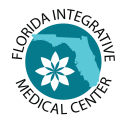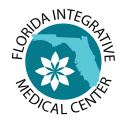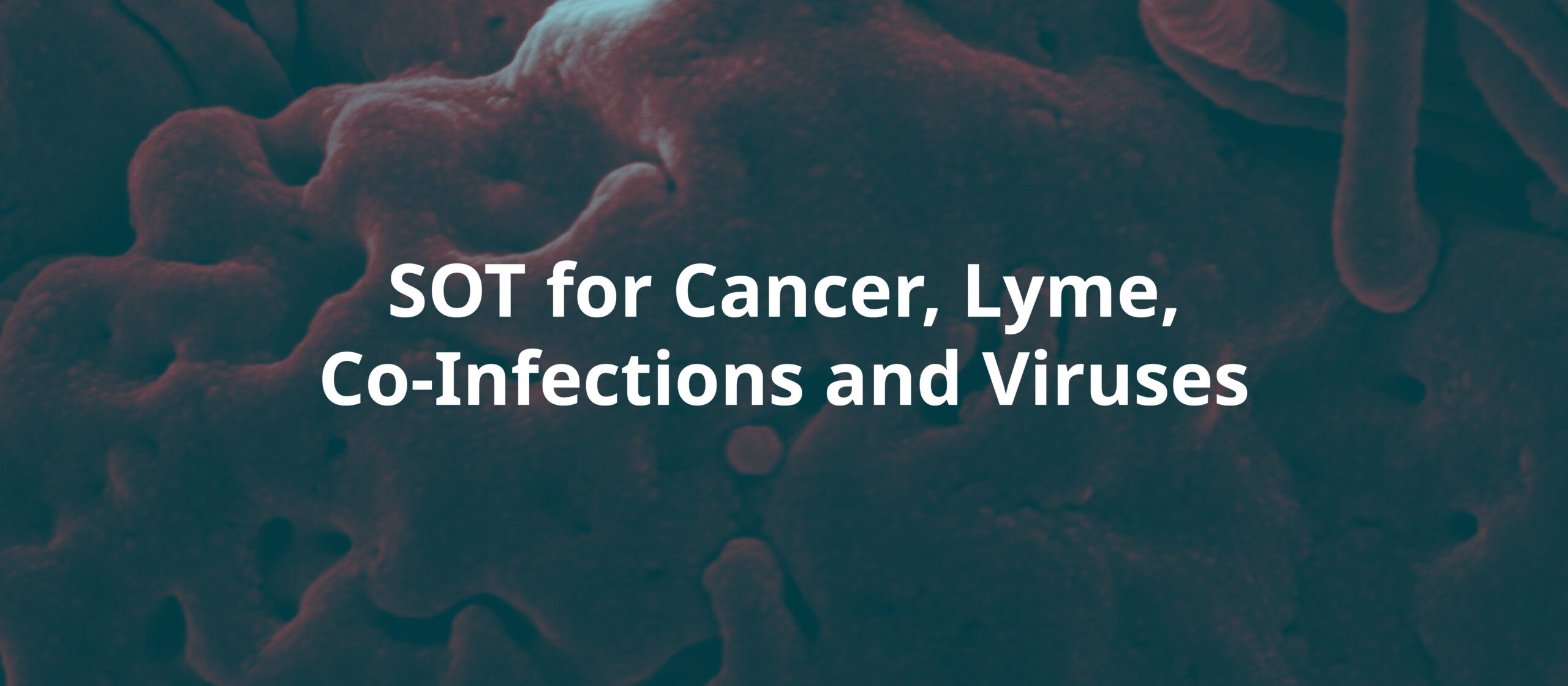Copyright Florida Integrative Medical Center 2024 © All rights Reserved



SOT for Cancer, Lyme, Co-Infections and Viruses
Supportive Oligonucleotide Therapy (SOT) is a therapy for infections and cancer. The therapys are made from the patients’ blood and therefore are tailored to each patient. By silencing a critical gene of the infectious agent, or cancer cell, it is able to kill them.
Research Genetic Cancer Center (RGCC), a medical genetics company in Greece, has done a lot of work to enhance SOT. SOT started at RGCC labs almost 10 years ago. SOT is also known as Antisense Oligodeoxynucleotide Therapy (AOT). SOT is based on many years of research by European and American companies and universities.

SOT blocks the function of a critical gene. Nucleotides are the building blocks of DNA and RNA. “Oligo” means “few”. Oligonucleotides consist of a sequence of nucleotides rarely more than 20 bases long. The term “antisense” oligodeoxynucleotide refers to the fact that it is designed to bind to complementary RNA bases in the target cell.
A mRNA molecule that is bound to an antisense strand of messenger RNA cannot bind to the ribosome and therefore its protein cannot be made. This makes the target gene nonfunctional. Blocking the function of a critical gene causes the cell to die.
It is a small oligodeoxynucleotide which is complementary to a sequence of nucleotides. SOT kills a cancer cell by targeting a gene which is responsible for anti-apoptotic signals. Each individual gene is related to anti-apoptotic signals inside cancer cells. Apoptosis is programmed cell death. The SOT molecule blocks the expression which encodes a protein with anti-apoptotic effect.
RGCC has state-of-the-art equipment and technology which enables them to identify specific gene sequences of various infectious agents and cancer cells. The patient’s blood is drawn at our clinic to obtain the pathogens and circulating cancer stem cells (CSCs). RGCC is able to identify the main gene epitope (gene sequence) of the target genes and to create the SOT. RGCC’s unique verification process includes cross-referencing the main gene sequences with the information stored in an international genetics database. This makes it possible to have the most accurate SOT and to maximize the success of therapy. SOT does not interfere with the functioning of normal human cells, tissues, or organs. The term “sense strand” refers to the replication genes, the genes that cause cell replication. Once these genes are identified, RGCC creates an anti-copy, or antisense strand, of the replication sequences of the translocation genes. This anti-copy is a complementary copy of the DNA sequences that codes for replication.
RGCC Labs uses miRNA (micro RNAs) to influence only certain gene expressions and not to change genetic structure.
Subsequently, this anti-copy is surrounded with a synthetic messenger RNA (mRNA) to enable it to penetrate the target’s cell wall. Next, this mRNA is replicated to ~500 million to 1 billion copies of SOT molecules. Finally, RGCC ships the SOT to the doctor’s office where it will be administered to the patient. After the intravenous infusion, the SOT molecules will work around the clock for about six months.
Follow-up testing is strongly recommended to see when the virus/Lyme infection is resolved and, in cancer, to confirm the amount of cancer stem cells (CSCs) decreasing.
A unique SOT is needed for each infection. Patients with multiple infections will need more than one SOT. Usually only one therapy is needed per infection. Occasionally a second SOT, for the same infection, is required. In this case the second SOT is administered about 6 months later.
SOT is not an immune therapy because it does not modulate the immune system. Side effects are usually minimal and may include headaches, body aches, general malaise, sweating, diarrhea, cough, and fever. Usually, these symptoms resolve within 24-48 hours.
Caution is needed in patients with a large tumor burden. SOT induces rapid apoptosis in circulating tumor cells (CTCs), circulating cancer stem cells, primary tumor cells, and metastatic tumors. In addition, it is able to cross the blood-brain barrier. The doctor may recommend a PET/CT, CT, or MRI scan prior to the SOT to assess tumor burden. Cancer with metastasis could result in Tumor Lysis Syndrome (TLS), which can be life-threatening.
Currently, the SOT is available for the following Lyme species and co-infections:
Babesia odocoilei
Babesia microti
Babesia bigemina
Babesia divergens
Babesia duncani
Babesia bovis
Bartonella henselae
Bartonella bacilliformis
Bartonella vinsonii
Bartonella quintana
Bartonella eluzabethae
Borrelia mayonii
Borrelia burgdorferi
Borrelia garinii
Borrelia bissettii
Borrelia bavariensis
Borrelia miyamotoi
Borrelia valaisiana
Borrelia afzelii
Borrelia finlandensis
Borrelia recurrentis
Borrelia valaisiana
Borrelia hermsii
Borrelia lusitaniae
Borrelia sinica
Borrelia kurttenbachii
Borrelia genomospecies
Borrelia turcica
Borrelia turicatae
Borrelia miyamotoi
Borellia californiensis
Candidatus Borrelia
Candidatus Borrelia tachyglossi
Anaplasma phacocytophilum
Ricketsia rickettsi
Enrlichia chaffeensis
and for the following viruses:
EBV (Epstein Barr Virus)
CMV (cytomegalovirus)
Coxsackie virus (Types A & B)
VZV (Varicella Zoster virus (chicken pox, shingles))
HHV1/HSV1 (oral herpes virus)
HHV2/HSV2 (genital herpes virus)
HHV6 (Types A & B) (human herpes virus 6)
HPV (16/18) (human papillomavirus)
HPV (6/11) (human papillomavirus)
HTLV1 (Human T-cell lymphotropic Virus)
HBV (Hepatitis B Virus)
HCV (Hepatitis C Virus)
HIV (Human Immunodeficiency Virus)
SOT terminates its gene replication sequences, thus eliminating the next lifecycle and eradicating it from the body. If a patient has multiple active infections, then multiple SOT therapys will be needed for each infection.
SOT is not an immune therapy, because it does not work by modulating the immune system. Because it is highly compatible with the patient, the side effects are usually minimal. Potential side effects may include headaches, body aches, general malaise, sweating, diarrhea, cough, fever, (generally <=101°F), and mild to moderate flulike symptoms. Usually, these symptoms resolve within 24-48 hours or a week at most.
SOT for Cancer: SOT induces rapid apoptosis in circulating tumor cells (CTCs), circulating cancer stem cells (CSCs), primary tumor cells, and metastatic tumors. In addition, it is able to cross the blood-brain barrier. As it penetrates into these cells it will interfere with their ability to replicate. The doctor will recommend a PET/CT, CT, or MRI scan prior to the SOT to assess the patient’s cancer for any metastasis. To reduce the risk of mild to severe adverse reactions, and to adjust the SOT dosing and timing, according to each individual case. Cancer with metastasis could result in Tumor Lysis Syndrome (TLS), which can be life threatening.
Lyme Symptom Chart
Lyme-Late Stage
Joints: Arthritis-Like Joint Pain & Swelling, Migrating Joint Pain
Back Pain
Chronic Fatigue
Poor Sleep
Brain Fog
Poor Concentration
Inability to Focus
Headache
Wooziness/Lightheaded
Vertigo
Memory Loss-Especially Short Term
Speech Difficulties
Word Finding Problems
Facial Paralysis
Fibromyalgia
Gait
Balance Problems
Motion Sickness
Eyes: Blurred Vision
Floaters, Chronic Conjunctivitis
Light Sensitivity
Ears: Ringing in The Ears, Hearing Loss, Noise Sensitivity
Cardiovascular
Heart Attack
Muscular: Impaired Muscle Coordination, Impaired Reflexes, Aches, Pain, Weakness
Nerve Symptoms: Numbness, Tingling, Burning Vibrating, Shooting Pains
Gastrointestinal: Chronic Upset Stomach, Change in Bowels
Psychiatric: Impulsivity, Aggression, Bipolar, Depression, Dementia, Eating Disorders, Hallucinations, Mood Swings, Panic Attacks, Paranoia, Schizophrenia, Suicide
Babesiosis
High Fever at Onset
Overall Sick Feeling
Fatigue/Excessive Sleepiness
Night Sweats, Chills
Neurological: Dizziness, Feeling Spacey
Headaches (Migraine-Like, Persistent, And Especially Involving the Back of The Head and Upper Neck Areas)
Lymph Gland Swelling
Episodes of Breathlessness “Air Hunger” And or Cough
Decreased Appetite or Nausea
Spleen And/or Liver Enlargement
Lab Abnormalities May Include Low White Blood Count, Low Platelet Counts, Mild Elevation of Liver Enzymes, And Elevated “Sed Rate”
Psychiatric: Anxiety, Panic Attacks, Depression
Muscular: Severe Muscle Pains
Bartonella
Joint Pain and Stiffness
Low Grade Fevers
Feeling of Coming Down with The Flu. Fatigue with Agitation
Sweat, Often in The Morning or Late Afternoon
Poor Sleep (Especially Falling Asleep)
Headaches, Frontal or Top of Head and Confused with Sinus
Eyes: Blurred Vision Episodes, Red Eyes, Dry Eyes, Depth Perception, Retinal Problems, Light Sensitivity
Ears: Ringing in The Ears, Hearing Problems, Sound Sensitivity
Sore Throats-Recurring Swollen Glands Especially Neck and Under Arms
Gastrointestinal: Gut Symptoms, Especially Acid Reflux
Psychiatric: Anxiety, Panic Attacks, Or Excessive Worry
Agitation, Irritation, Rage, Impulsivity, Or Aggression
Episodes of Confusion and Disorientation
Seizure Like Episodes
Muscular: Muscle Pains, Especially in The Calves, May Be Twitching and Cramping
Foot Pain in The Morning Involving the Heels or Soles of The Feet. (Sometimes Misdiagnosed as Plantar Fasciitis) Shin Bone Pain and Tenderness
Nerve Irritation Symptoms: Burning, Vibrating, Numb and Shooting Tremors and/or Muscle Twitching
Cardiovascular: Heart Palpitations and Strange Chest Pains. Episodes of Breathlessness
Skin: Strange Rashes Recurring, Red Stretch Marks, Peculiar Tender Lumps, Nodules Along the Side of The Legs or Arms, Spider Veins.
Antisense Technology
AOT for Lyme and Co-Viruses
AOT is a treatment that was originally created in Europe over 20 years ago by the name of antisense oligonucleotide therapy (AOT).
If you are searching online for this treatment, it is best to look for it under the name of Antisense Oligonucleotide Therapy. There are lots of research from European and American based companies and universities.
RGCC labs in Greece has improved this technology over the previous technology and renamed it as an SOT because they create a treatment based on the patient’s unique genotype that is tested from their blood. We know of no other laboratory in the world that is creating this unique process. In the United States, we now cure hepatitis C with this exact same FDA approved technology. So, if we can turn off hepatitis C with one dose of an anti-sense therapy then we can definitely turn off the other replication cycles of Lyme disease, Lyme co-infections, viruses and even cancer cells.
Over the past two decades, Anti-Sense Oligonucleotide Technology has emerged as a valid approach to selectively modulate gene expressions in various targets. The recent acceleration of science and the ability to identify new molecular targets for cancer, Lyme and other viruses, has driven new advances in this technology. The limited effectiveness of conventional treatment strategies has focused considerable interest on the technology and development of new types of gene silencing therapies.
